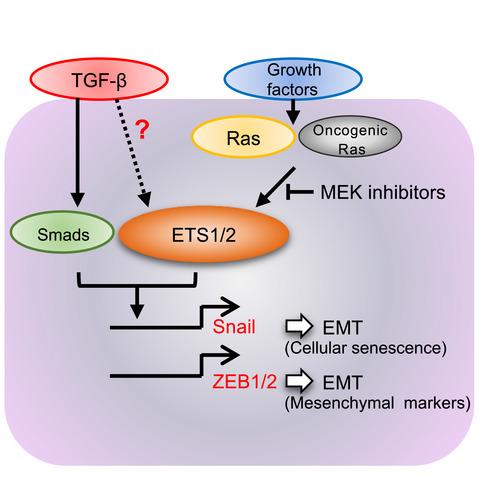当前位置:
X-MOL 学术
›
FEBS Open Bio
›
论文详情
Our official English website, www.x-mol.net, welcomes your
feedback! (Note: you will need to create a separate account there.)
Ets family proteins regulate the EMT transcription factors Snail and ZEB in cancer cells
FEBS Open Bio ( IF 2.8 ) Pub Date : 2022-04-22 , DOI: 10.1002/2211-5463.13415 Mai Koizumi Ichikawa 1, 2, 3 , Kaori Endo 1, 2 , Yuka Itoh 1 , Asami Hotta Osada 3 , Yujiro Kimura 3 , Koichiro Ueki 3 , Kunio Yoshizawa 3 , Keiji Miyazawa 1 , Masao Saitoh 1, 2
FEBS Open Bio ( IF 2.8 ) Pub Date : 2022-04-22 , DOI: 10.1002/2211-5463.13415 Mai Koizumi Ichikawa 1, 2, 3 , Kaori Endo 1, 2 , Yuka Itoh 1 , Asami Hotta Osada 3 , Yujiro Kimura 3 , Koichiro Ueki 3 , Kunio Yoshizawa 3 , Keiji Miyazawa 1 , Masao Saitoh 1, 2
Affiliation

|
The epithelial–mesenchymal transition (EMT) is a crucial morphological event that occurs during epithelial tumor progression. Snail and ZEB1/2 (ZEB1 and ZEB2), known as EMT transcription factors, are key regulators of this transition. ZEB1/2 are positively correlated with EMT phenotypes and the aggressiveness of cancers. On the contrary, Snail is also correlated with the aggressiveness of cancers, but is not correlated with the expression of EMT marker proteins. Snail is induced by transforming growth factor-β (TGF-β), a well-known inducer of EMT, in various cancer cells. Interestingly, Snail induction by TGF-β is markedly enhanced by active Ras signals. Thus, cancer cells harboring an active Ras mutation exhibit a drastic induction of Snail by TGF-β alone. Here, we found that members of the E26 transformation-specific (Ets) transcription factor family, Ets1 and Ets2, contribute to the upregulation of both Snail and ZEB1/2. Snail induction by TGF-β and active Ras is dramatically inhibited using siRNAs against both Ets1 and Ets2 together, but not on their own; in addition, siRNAs against both Ets1 and Ets2 also downregulate the constitutive expression of Snail and ZEB1/2 in cancer cells. Examination of several alternatively spliced variants of Ets1 revealed that p54-Ets1, which includes exon VII, but not p42-Ets1, which excludes exon VII, regulates the expression of the EMT transcription factors, suggesting that Ets1 is a crucial molecule for regulating Snail and ZEB1/2, and thus cancer progression is mediated through post-translational modification of the exon VII domain.
中文翻译:

Ets 家族蛋白调节癌细胞中的 EMT 转录因子 Snail 和 ZEB
上皮 - 间质转化(EMT)是上皮肿瘤进展过程中发生的关键形态事件。Snail 和 ZEB1/2(ZEB1 和 ZEB2)被称为 EMT 转录因子,是这一转变的关键调节因子。ZEB1/2 与 EMT 表型和癌症的侵袭性呈正相关。相反,Snail 也与癌症的侵袭性相关,但与 EMT 标记蛋白的表达无关。Snail 是由转化生长因子-β (TGF-β),一种众所周知的 EMT 诱导剂,在各种癌细胞中诱导的。有趣的是,活性 Ras 信号显着增强了 TGF-β 对 Snail 的诱导作用。因此,具有活性 Ras 突变的癌细胞表现出仅由 TGF-β 对 Snail 的强烈诱导。这里,我们发现 E26 转化特异性 (Ets) 转录因子家族的成员 Ets1 和 Ets2 有助于 Snail 和 ZEB1/2 的上调。使用同时针对 Ets1 和 Ets2 的 siRNA 可显着抑制 TGF-β 和活性 Ras 对蜗牛的诱导,但不能单独使用;此外,针对 Ets1 和 Ets2 的 siRNA 也会下调癌细胞中 Snail 和 ZEB1/2 的组成型表达。检查 Ets1 的几个可变剪接变体显示 p54-Ets1,包括外显子 VII,但不包括 p42-Ets1,不包括外显子 VII,调节 EMT 转录因子的表达,表明 Ets1 是调节 Snail 和ZEB1/2,因此癌症进展是通过外显子 VII 结构域的翻译后修饰介导的。有助于 Snail 和 ZEB1/2 的上调。使用同时针对 Ets1 和 Ets2 的 siRNA 可显着抑制 TGF-β 和活性 Ras 对蜗牛的诱导,但不能单独使用;此外,针对 Ets1 和 Ets2 的 siRNA 也会下调癌细胞中 Snail 和 ZEB1/2 的组成型表达。检查 Ets1 的几个可变剪接变体显示 p54-Ets1,包括外显子 VII,但不包括 p42-Ets1,不包括外显子 VII,调节 EMT 转录因子的表达,表明 Ets1 是调节 Snail 和ZEB1/2,因此癌症进展是通过外显子 VII 结构域的翻译后修饰介导的。有助于 Snail 和 ZEB1/2 的上调。使用同时针对 Ets1 和 Ets2 的 siRNA 可显着抑制 TGF-β 和活性 Ras 对蜗牛的诱导,但不能单独使用;此外,针对 Ets1 和 Ets2 的 siRNA 也会下调癌细胞中 Snail 和 ZEB1/2 的组成型表达。检查 Ets1 的几个可变剪接变体显示 p54-Ets1,包括外显子 VII,但不包括 p42-Ets1,不包括外显子 VII,调节 EMT 转录因子的表达,表明 Ets1 是调节 Snail 和ZEB1/2,因此癌症进展是通过外显子 VII 结构域的翻译后修饰介导的。使用同时针对 Ets1 和 Ets2 的 siRNA 可显着抑制 TGF-β 和活性 Ras 对蜗牛的诱导,但不能单独使用;此外,针对 Ets1 和 Ets2 的 siRNA 也会下调癌细胞中 Snail 和 ZEB1/2 的组成型表达。检查 Ets1 的几个可变剪接变体显示 p54-Ets1,包括外显子 VII,但不包括 p42-Ets1,不包括外显子 VII,调节 EMT 转录因子的表达,表明 Ets1 是调节 Snail 和ZEB1/2,因此癌症进展是通过外显子 VII 结构域的翻译后修饰介导的。使用同时针对 Ets1 和 Ets2 的 siRNA 可显着抑制 TGF-β 和活性 Ras 对蜗牛的诱导,但不能单独使用;此外,针对 Ets1 和 Ets2 的 siRNA 也会下调癌细胞中 Snail 和 ZEB1/2 的组成型表达。检查 Ets1 的几个可变剪接变体显示 p54-Ets1,包括外显子 VII,但不包括 p42-Ets1,不包括外显子 VII,调节 EMT 转录因子的表达,表明 Ets1 是调节 Snail 和ZEB1/2,因此癌症进展是通过外显子 VII 结构域的翻译后修饰介导的。
更新日期:2022-04-22
中文翻译:

Ets 家族蛋白调节癌细胞中的 EMT 转录因子 Snail 和 ZEB
上皮 - 间质转化(EMT)是上皮肿瘤进展过程中发生的关键形态事件。Snail 和 ZEB1/2(ZEB1 和 ZEB2)被称为 EMT 转录因子,是这一转变的关键调节因子。ZEB1/2 与 EMT 表型和癌症的侵袭性呈正相关。相反,Snail 也与癌症的侵袭性相关,但与 EMT 标记蛋白的表达无关。Snail 是由转化生长因子-β (TGF-β),一种众所周知的 EMT 诱导剂,在各种癌细胞中诱导的。有趣的是,活性 Ras 信号显着增强了 TGF-β 对 Snail 的诱导作用。因此,具有活性 Ras 突变的癌细胞表现出仅由 TGF-β 对 Snail 的强烈诱导。这里,我们发现 E26 转化特异性 (Ets) 转录因子家族的成员 Ets1 和 Ets2 有助于 Snail 和 ZEB1/2 的上调。使用同时针对 Ets1 和 Ets2 的 siRNA 可显着抑制 TGF-β 和活性 Ras 对蜗牛的诱导,但不能单独使用;此外,针对 Ets1 和 Ets2 的 siRNA 也会下调癌细胞中 Snail 和 ZEB1/2 的组成型表达。检查 Ets1 的几个可变剪接变体显示 p54-Ets1,包括外显子 VII,但不包括 p42-Ets1,不包括外显子 VII,调节 EMT 转录因子的表达,表明 Ets1 是调节 Snail 和ZEB1/2,因此癌症进展是通过外显子 VII 结构域的翻译后修饰介导的。有助于 Snail 和 ZEB1/2 的上调。使用同时针对 Ets1 和 Ets2 的 siRNA 可显着抑制 TGF-β 和活性 Ras 对蜗牛的诱导,但不能单独使用;此外,针对 Ets1 和 Ets2 的 siRNA 也会下调癌细胞中 Snail 和 ZEB1/2 的组成型表达。检查 Ets1 的几个可变剪接变体显示 p54-Ets1,包括外显子 VII,但不包括 p42-Ets1,不包括外显子 VII,调节 EMT 转录因子的表达,表明 Ets1 是调节 Snail 和ZEB1/2,因此癌症进展是通过外显子 VII 结构域的翻译后修饰介导的。有助于 Snail 和 ZEB1/2 的上调。使用同时针对 Ets1 和 Ets2 的 siRNA 可显着抑制 TGF-β 和活性 Ras 对蜗牛的诱导,但不能单独使用;此外,针对 Ets1 和 Ets2 的 siRNA 也会下调癌细胞中 Snail 和 ZEB1/2 的组成型表达。检查 Ets1 的几个可变剪接变体显示 p54-Ets1,包括外显子 VII,但不包括 p42-Ets1,不包括外显子 VII,调节 EMT 转录因子的表达,表明 Ets1 是调节 Snail 和ZEB1/2,因此癌症进展是通过外显子 VII 结构域的翻译后修饰介导的。使用同时针对 Ets1 和 Ets2 的 siRNA 可显着抑制 TGF-β 和活性 Ras 对蜗牛的诱导,但不能单独使用;此外,针对 Ets1 和 Ets2 的 siRNA 也会下调癌细胞中 Snail 和 ZEB1/2 的组成型表达。检查 Ets1 的几个可变剪接变体显示 p54-Ets1,包括外显子 VII,但不包括 p42-Ets1,不包括外显子 VII,调节 EMT 转录因子的表达,表明 Ets1 是调节 Snail 和ZEB1/2,因此癌症进展是通过外显子 VII 结构域的翻译后修饰介导的。使用同时针对 Ets1 和 Ets2 的 siRNA 可显着抑制 TGF-β 和活性 Ras 对蜗牛的诱导,但不能单独使用;此外,针对 Ets1 和 Ets2 的 siRNA 也会下调癌细胞中 Snail 和 ZEB1/2 的组成型表达。检查 Ets1 的几个可变剪接变体显示 p54-Ets1,包括外显子 VII,但不包括 p42-Ets1,不包括外显子 VII,调节 EMT 转录因子的表达,表明 Ets1 是调节 Snail 和ZEB1/2,因此癌症进展是通过外显子 VII 结构域的翻译后修饰介导的。






























 京公网安备 11010802027423号
京公网安备 11010802027423号